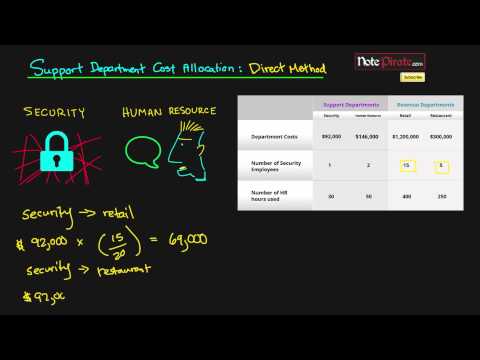14.2: Direct Method of Allocation
- Page ID
- 65795
\( \newcommand{\vecs}[1]{\overset { \scriptstyle \rightharpoonup} {\mathbf{#1}} } \)
\( \newcommand{\vecd}[1]{\overset{-\!-\!\rightharpoonup}{\vphantom{a}\smash {#1}}} \)
\( \newcommand{\id}{\mathrm{id}}\) \( \newcommand{\Span}{\mathrm{span}}\)
( \newcommand{\kernel}{\mathrm{null}\,}\) \( \newcommand{\range}{\mathrm{range}\,}\)
\( \newcommand{\RealPart}{\mathrm{Re}}\) \( \newcommand{\ImaginaryPart}{\mathrm{Im}}\)
\( \newcommand{\Argument}{\mathrm{Arg}}\) \( \newcommand{\norm}[1]{\| #1 \|}\)
\( \newcommand{\inner}[2]{\langle #1, #2 \rangle}\)
\( \newcommand{\Span}{\mathrm{span}}\)
\( \newcommand{\id}{\mathrm{id}}\)
\( \newcommand{\Span}{\mathrm{span}}\)
\( \newcommand{\kernel}{\mathrm{null}\,}\)
\( \newcommand{\range}{\mathrm{range}\,}\)
\( \newcommand{\RealPart}{\mathrm{Re}}\)
\( \newcommand{\ImaginaryPart}{\mathrm{Im}}\)
\( \newcommand{\Argument}{\mathrm{Arg}}\)
\( \newcommand{\norm}[1]{\| #1 \|}\)
\( \newcommand{\inner}[2]{\langle #1, #2 \rangle}\)
\( \newcommand{\Span}{\mathrm{span}}\) \( \newcommand{\AA}{\unicode[.8,0]{x212B}}\)
\( \newcommand{\vectorA}[1]{\vec{#1}} % arrow\)
\( \newcommand{\vectorAt}[1]{\vec{\text{#1}}} % arrow\)
\( \newcommand{\vectorB}[1]{\overset { \scriptstyle \rightharpoonup} {\mathbf{#1}} } \)
\( \newcommand{\vectorC}[1]{\textbf{#1}} \)
\( \newcommand{\vectorD}[1]{\overrightarrow{#1}} \)
\( \newcommand{\vectorDt}[1]{\overrightarrow{\text{#1}}} \)
\( \newcommand{\vectE}[1]{\overset{-\!-\!\rightharpoonup}{\vphantom{a}\smash{\mathbf {#1}}}} \)
\( \newcommand{\vecs}[1]{\overset { \scriptstyle \rightharpoonup} {\mathbf{#1}} } \)
\( \newcommand{\vecd}[1]{\overset{-\!-\!\rightharpoonup}{\vphantom{a}\smash {#1}}} \)
The direct method allocates costs of each of the service departments to each operating department based on each department’s share of the allocation base. Services used by other service departments are ignored. This means the direct method does not recognize service performed by other service departments. For example, if Service Department A uses some of Service Department B’s services, these services would be ignored in the cost allocation process. Because these services are not allocated to other service departments, some accountants
believe the direct method is not accurate.
Let’s look at another example. A company has 2 service departments, Maintenance and Administration, and 2 operating departments (Department 1 and 2 for simplicity). The costs of the maintenance department are allocated based on the machine-hours used. For the
administration department, the cost allocation is based on the number of employees. The following information is provided:
| Service Dept | Operating Dept | |||
| Maintenance | Administration | 1 | 2 | |
| Costs | $8,000 | $4,000 | $32,000 | $36,000 |
| Machine-hours used | 1,000 | 2,000 | 1,500 | 2,500 |
| Number of Employees | 100 | 200 | 250 | 150 |
Remember how we calculate predetermined overhead rates? We will need that same formula again. The formula to calculate the allocation rate will be slightly modified for service department cost but will be:
| Service Dept Cost |
| TOTAL Cost Driver (operating depts only) |
Notice, we use the operating department cost drivers only since we are allocating the service department cost to operating departments only and not to another service department. Maintenance uses machine-hours as the cost driver or basis and Administration uses number of employees. We can calculate the service department allocation rates as follows:
| Maintenance Dept Cost | = $8,000 | =$8,000 | = $2 per machine hour | |
| TOTAL Machine Hours (operating depts only) | (1,500 + 2,500) | 4,000 | ||
| Administration Dept Cost | = $4,000 | =$4,000 | = $10 per employee | |
| TOTAL Employees (operating depts only) | (250 + 150) | 400 | ||
To allocate the service department costs to each operating department, we will take the amount of the cost driver (machine hours for maintenance and employees for administration) x the allocation rate we just calculated.
| Operating Dept 1 | Operating Dept 2 | |
| Maintenance | $3,000 | $5,000 |
| (1,500 mach hour x $2 per mach hr) | (2,500 mach hour x $2 per mach hr) | |
| Administration | $2,500 | $1,500 |
| (250 employees x $10 per employee) | (150 employees x $10 per employee) |
Notice how the total maintenance amount allocated to the two departments (3,000 + 5,000) equals the maintenance department cost of $8,000. The same applies to administration as the total cost is $4,000 and we allocated a total of $4,000 (2,500 + 1,500). We can summarize the changes to the costs of each department:
| Service Dept | Operating Dept | |||
| Maintenance | Administration | 1 | 2 | |
| Costs | $8,000 | $4,000 | $32,000 | $36,000 |
| Allocation of maintenance | ($8,000) | 3,000 | 5,000 | |
| Allocation of administration | ($4,000) | 2,500 | 1,500 | |
| Total Costs | $0 | $0 | $37,500 | $42,500 |
Contributors and Attributions
- Accounting Principles: A Business Perspective.. Authored by: James Don Edwards, University of Georgia & Roger H. Hermanson, Georgia State University.. Provided by: Endeavour International Corporation. Project: The Global Text Project.. License: CC BY: Attribution
- Support Cost Allocation Using the Direct Method (Managerial Accounting Tutorial #32) . Authored by: Note Pirate. Located at: https://youtu.be/LxrmRNNW1PI. License: All Rights Reserved. License Terms: Standard YouTube License


